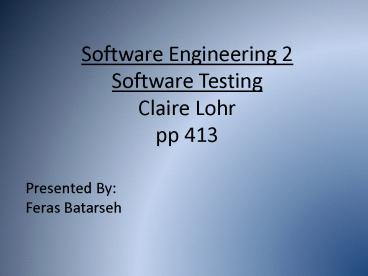Software Engineering 2 Software Testing Claire Lohr pp 413 PowerPoint PPT Presentation
1 / 23
Title: Software Engineering 2 Software Testing Claire Lohr pp 413
1
Software Engineering 2Software TestingClaire
Lohrpp 413
Presented ByFeras Batarseh
2
Definition
- IEEE 610.12
- An activity in which a system or component
- under specified conditions, the results are
- observed or recorded, and an evaluation is
- made of some aspect of the system or
- component.
3
Attributes
- Software engineer intuition and experience.
- Specification.
- Code.
- Dataflow.
- Fault.
- Usage.
- Nature of the application.
4
Types of Testing
- Equivalence class partitioning.
- Boundary value.
- Decision table.
- Exploratory.
- Operational profile.
5
Equivalence class partitioning
- According to two attributes
- Valid.
- Invalid.
- Example age 0-120 (valid)
- age lt0 and gt120 (Invalid)
6
Steps for ECP
- Define valid and invalid values.
- Test as many valid classes together.
- Do one test for each invalid class.
7
Boundary value
- Must test the following
- Legally defined minimum.
- Legally defined maximum.
- The first possible value below the legally min.
- The first possible value above the legally max.
- Age ex 0, 120, -1, 121
8
Decision table
- Lists all conditions and all resultant outputs.
- Y yes
- N no
- 1yes and no.
9
Exploratory testing
- Emphasizing planning the focus of the testing
- process.
- Doesnt require pre-planning.
- When test begins, modifications are still
- allowed.
- Test results modify the plan accordingly.
10
Operational profile
- Number of tests to be done follows the model of
- how much it is used during operation.
- Test more for features that are used more.
11
Testing Levels
- Levels vary from organization to organization,
- and from project to project.
- Some parameters
- Size.
- Complexity.
- Safety criticality.
- Experience of staff.
- Desire for certification(ISO, CMMI)
12
Testing Levels (cont.)
- Operational testing
- Software units, DB, integrated components,
- requirements and integration.
- Maintenance process
- modified and un-modified parts, migration
- verification, parallel testing, all development
- levels for improvements.
- Supporting process
- Verification and validation.
13
Testing strategies
- Testing all combinations is impossible!
- Macro
- Time to market
- Amount of functionality to be delivered
- Quality of product
- Micro
- More automation to speed process
- Better selection of test cases
- Less turnovers in testing staff.
14
Testing strategies (cont.)
- For functionality changes
- Tracing requirements to see cases affected by
- changes.
- Modular testing.
- For quality of product
- More variety in types.
- Better tools.
- Better unit test tools for developers
15
Testing strategies (cont.2)
- To control test effort cost
- PM tool for estimations.
- Add root cause analysis.
16
Test Design
- Art and science.
- Structured
- Boundary value
- Decision table
- Equivalence class partitioning
- Un structured
- Random
- Ad hoc
- Exploratory
17
Test Coverage of code
- Impossible to cover all the code.
- Depends on the definition of covering!
- Does it mean executing, reading, testing?
- Use Tom McCabes basis technique.
18
Tom McCabes basis technique.
- 1-Draw a flow graph.(nodes and edges)
- 2-Compute the metric cyclomatic complexity
(nodes). - No.edges-no.Nodes2cc
- 3-Choose paths. (cover all nodes and edges)
19
Test Execution
- Defined in a test plan (Pseudo code and
- flow graph)
- Cover all specifications is important.(categorize
- according to testable or not)
- Define components hardware, software,
- personnel, data, automated tools.
20
Testing documentation
- Media vary depending on level of detail
- Word doc.
- Spread sheets.
- Databases.
- Within automated test tools.
21
IEEE Testing documentation
- Test plan
- Test design
- Test cases
- Test procedures
- Test logos
- Incident reports
- Test summary report
- Test item transmittal report
22
Test management
- Estimating schedules.
- Planning for staffing and training.
- Identifying and planning tasks.
- Monitoring the execution of the plans and
- re-planning based on results.
23
- Any questions?
- Thank You for your attention.

